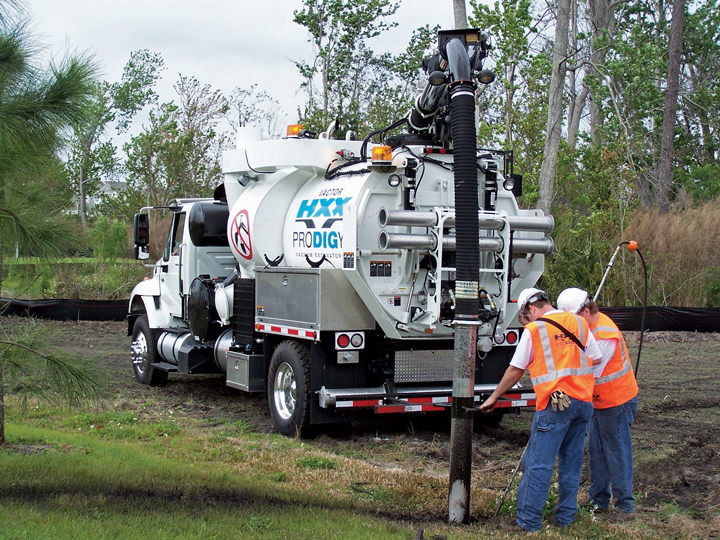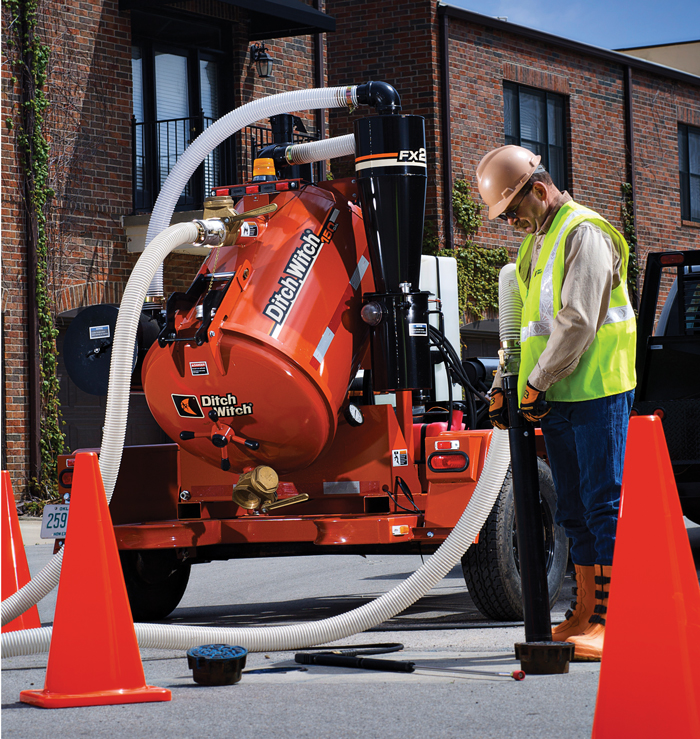Utilities Unearthed

“With the vast amount of underground utilities, visually verifying their location prior to mechanical excavation is essential to protecting this infrastructure,” says Ben Schmitt, Product Manager for Vactor Mfg. “Electronic locating methods are not always accurate and may also miss unknown utilities in the area. Visually locating these utilities with vacuum excavation is essential to mitigating risk of striking underground utilities. The risk of striking a fiber-optic, electrical or gas line can be thousands, and sometimes millions, of dollars in fines, lawsuits and even death.”
The search for a vacuum excavator begins the same as any piece of equipment: know the job you’re planning to complete. By identifying the typical type of work your crew will perform, the equipment decision process will run a lot more smoothly.
“With vacuum excavation equipment, there are many options available,” says Schmitt. “The first consideration should be the size of excavations to be completed with the equipment. Knowing this will allow you to select the proper size machine for the job. Knowing the intended usage of the equipment will also help you to determine whether to rent or buy your equipment based on your financial needs.”
Speaking of financial needs and demand, another important consideration is whether a trailer- or truck-mounted unit would work for both a crew’s needs and budget. For example, prices can range anywhere from $25,000 for a small trailer unit up to $500,000 for truck-mounted vacuum excavators.
“If a customer is looking at a trailer unit, he or she must consider what vehicle they have to tow it with or what they will need,” says Jason Proctor, Product Manager for Ditch Witch. “Aside from price, it’s a preference on whether they prefer to drive or tow their vac.”
On top of the size of machine and style of the unit, CFM and vacuum pressure are also important. For those who may be handling spoils that are very thick and heavy or at greater depths, more CFM and vacuum pressure is required.
“When considering the application, determine if you’ll need a high CFM or standard CFM system,” says Brian Showley, Vice President of Vac-Tron. “High CFM systems are becoming more and more popular because they allow for the use of a strong-arm or hydraulic boom and a larger diameter suction hose.”
The Great Debate: Air vs. Water
When exploring vacuum excavation systems, the decision between an air or hydro unit is an important one. While both have their advantages and disadvantages, hydro continues to be the most popular among contractors, thanks to its speed and productivity.
“Hydro excavation is much faster than air vacuum excavation as water is able to move more material faster and more efficiently,” says Schmitt. “In frozen ground or harder materials, water can be heated with on-board water heaters to aid in cutting through these materials.”
Other notable advantages of hydro excavation include quieter operation for those performing the work, as well as less mess thanks to avoiding the dust component associated with air excavation.
On the flip side, one disadvantage of hydro excavation is that a contractor is unable to reuse the spoils since they are wet. This may result in having to load the spoils and dump them offsite.
Although it’s less common, air excavation is very advantageous when working in loamy, sandy soils. However, air doesn’t perform well in harder soils that contractors may face. In contrast to hydro, the spoils from air excavation are reusable — saving time and trips from the jobsite.
“The primary advantage of using an air excavator is that it keeps the spoils dry, which means they can be reused to fill the holes,” says Showley. “In addition, some DOTs will not allow hydro-excavation to take place near or underneath roadways.”
Schmitt adds: “Some utility companies, DOTs or power plants specify air vacuum excavation for a given job for a number of reasons. Air vacuum excavation is desired in applications where the soil tends to be loose, water is not readily available, in small-scale excavation projects or where immediate backfill of the hole is required. When working around buried electrical lines or brittle utilities, air vacuum excavation is often preferred due to the lower operating pressures.”
For contractors who can’t choose which medium best serves their needs, there are combination units available from companies such as Vactor, McLaughlin and Vac-Tron that allow operators to switch when needed.
Properly identifying underground utilities prior to excavation is of utmost importance to avoid costly damage and unsafe working conditions. Vacuum excavation assists in locating and exposing utilities to minimize risk when digging, and the use of these machines is expected to grow.
“The growing demand has been significant over the last five years with the damage prevention push, and I don’t think we’ve seen the end of that growth pattern just yet,” says Proctor. “It will stabilize at some point where a vacuum is common on every jobsite, but there’s still quite a bit of growth opportunity. There are areas that are very strict in the required use of vacuum excavation, and there are areas that don’t require it that I think soon will. Vacuum excavation is really going to continue to grow at a high rate.”
Pam Kleineke is Associate Editor of Utility Contractor.
 Lights, Camera, Safety!
Lights, Camera, Safety!
Ditch Witch Customers Eligible for Complimentary Vacuum Excavation Safety Video
As a complement to its Ditch Witch Safe Program, the Ditch Witch organization has partnered with the Association of Equipment Manufacturers (AEM) and four other members of AEM’s Underground Equipment Manufacturers Council (UEMC) to develop a video sharing instructions for safe, productive operation of vacuum excavation equipment.
“We are committed to helping underground contractors continue to expand and improve underground infrastructures while mitigating damage and exposure to unnecessary risk,” says Susan Harmon, Product Safety and Compliance Manager for The Charles Machine Works, manufacturer of Ditch Witch products.
Members of AEM, including Ditch Witch, recognize that more contractors are taking advantage of versatile, productive vacuum excavators, which are designed to minimize damage to utilities and contribute to a company’s overall damage prevention routine.
“Damage prevention is a shared responsibility, making communication and cooperation essential to reducing injury, lost time, cost and damaged equipment,” says Harmon.
The 19-minute DVD, produced in conjunction with Ditch Witch, Sewer Equipment, Vacall, Vactor and Vermeer, is available for purchase through the AEM Store and complements an existing 35-page vacuum excavation safety manual also available from AEM. Ditch Witch customers can e-mail info@ditchwitch.com for a complimentary copy.

 Lights, Camera, Safety!
Lights, Camera, Safety!


